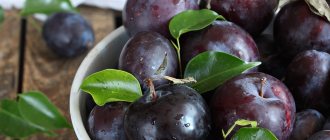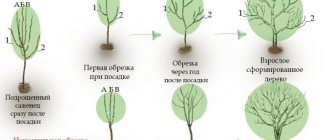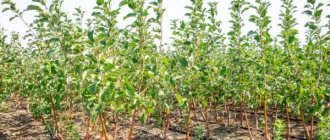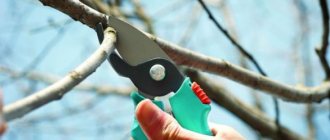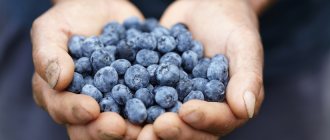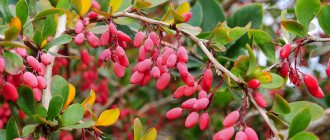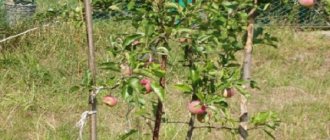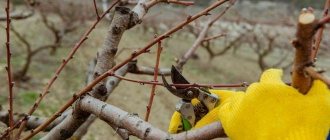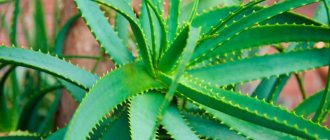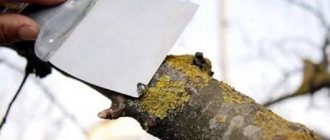Forming the crown of an apple tree is an important and rather complex part of plant care. Practice shows that on a tree that develops naturally, over time, the quality of the fruit deteriorates, winter hardiness decreases, fruiting ceases to be regular, and the branches lose strength and need supports. At the same time, on properly formed trees, apples do not lose their taste and marketable properties, the crown is able to withstand abundant harvests, and the regularity of fruiting corresponds to the varietal characteristics.
It must be remembered that pruning is a tough technique, and the fate of the tree largely depends on how correctly the gardener made the decision when removing this or that branch
Basic terms and features
To properly form an apple tree, you need to know the names and signs of the main components of the tree crown:
- The root collar is the conventional place of transition of the root into the trunk. It is located 5–7 cm below the grafting site.
- The stem is the part of the trunk from the root collar to the first skeletal branch.
- Branch of continuation of the main or skeletal branches of the first order - branches that form the frame (skeleton) of the tree. They extend directly from the trunk and have the greatest thickness and length. It is not recommended to allow skeletal branches to grow at right angles to the trunk.
- Branches of the second order are quite large, extending from the branches of the first order.
- The competitor is an undesirable strong vertical growth shoot growing inside the crown. Formed after pruning the central conductor and skeletal branches from a bud located below the bud for continued growth.
- The branch of continuation of the leader is formed after trimming the central conductor from a specially left bud.
- Overgrowing branch – branches of the fourth and fifth orders, located on the skeletal branches and branches of the second order. They are divided into vegetative (growth) and generative (fruit-bearing) branches.
Vegetative branches provide the growth of the tree. These also include spring shoots, continuation shoots, replacement shoots, top shoots and root shoots.
- The central conductor or leader is the part of the trunk from the lower skeletal branch to the base of the continuation branch of the leader. It is the main feeding branch for all branches of various orders.
- Top branch - strong fattening shoots that grow strictly vertically. They are not fruit-bearing, but with proper pruning they can become a second-order branch.
- Root shoots are adventitious buds that form on the root system and develop into adventitious shoots. They do not bear fruit and are most often a wild type of apple tree.
- Skeletal horizontal roots are skeletal roots of the first order.
- Vertical roots - serve to hold the tree in an upright position.
- Fibrous (adventitious) roots - spread up to 15 m in diameter, supply the tree with moisture. A. Departure angle is the angle at which a branch departs from its supporting branch. b. Climbing angle is the angle between the load-bearing branch and the downward or horizontal branch. V. The angle of inclination is the angle of bending of the branch from the vertical. It is used to determine the fruiting of branches - branches with a value less than 450 from the vertical grow quickly, but rarely bear fruit, and vice versa.
Beginner mistakes
Inexperienced gardeners often make mistakes both when choosing the timing of pruning and the technology for carrying out the work:
- They leave a tall stump with a bud, which will quickly give rise to a new shoot.
- The branch is cut too close to the base, resulting in a hollow when it dries out.
- A large branch is removed in one stage, which can lead to the bark on the trunk breaking and the formation of a poorly healing wound.
- They leave branches that are located at a very acute angle in relation to the trunk. In fruitful years, they easily break off and injure the trunk.
- Unsuitable materials (manure, synthetic materials) are used to cover wounds, which leads to infection of the plant.
Previous
Apple tree The best varieties of apple trees for the Moscow region
Next
Apple treeHow to deal with scab on an apple tree: treatment and treatment with drugs
Reasons for crown formation
The biological feature of plants is the desire to reproduce. For this reason, the apple tree produces new shoots every year and tends to set a large number of fruits. However, such fruits grow small, have an unattractive appearance, and their taste deteriorates significantly.
Forming the crown of an apple tree allows you to:
- prevent the occurrence of bacterial diseases resulting from increased leaf moisture;
- prevent long branches from breaking off, thereby protecting the tree from damage;
- improve fruit quality;
- increase productivity;
- extend the life of the apple tree;
- prevent the death of fruit branches located inside the crown;
- maintain the balance of branches with fruits, prevent them from bending and breaking;
- ensure sunlight reaches the tree leader and fruits;
- create conditions for harvesting without the use of auxiliary devices.
Lack of pruning for three or more years leads to early aging of the apple tree and a decrease in fruit quality by 50–70%.
Apple tree pruning time
It is impossible to give exact calendar dates for pruning an apple tree - they depend on the type of pruning and the growing region. The basic rule that determines the possibility of pruning is that such an operation can only be carried out when the tree is at rest. This means that when pruning in spring, it is carried out before the sap begins to flow, that is, before the buds swell. You should not do this too early - often return frosts below -15 °C lead to the tree becoming infected with cytosporosis. But it is also undesirable to be late - with the onset of active sap flow, the wounds will heal poorly and for a long time, which leads to abundant gum formation, the same cytosporosis and weakening of the apple tree. It should also be noted that most types of pruning are carried out in the spring. Autumn pruning should be carried out after the end of the growing season. Moreover, early spring dates are suitable for all regions, and autumn dates are only suitable for areas with warm winters. In summer, it is allowed to remove or shorten only thin branches with a diameter of no more than 5-8 mm.
Methods of crown formation
To give the crown of an apple tree the desired shape, the following methods are used:
- Pruning – allows you to regulate the growth of the tree. Depending on the time of the event it may be:
- winter (spring) - carried out in early spring before the start of sap flow, but after the threat of return frosts has passed;
- summer - carried out as necessary, in case of unwanted shoots;
- autumn - the formation of the crown after harvesting, but 1 month before the onset of frost.
- Green operation - pinching or removing young and immature shoots.
- Blinding (removal) of the buds - prevents the appearance of excess shoots, saves nutrients, redirecting them in the right direction. The least traumatic way.
- Bending and fixing branches - allows you to regulate growth, changes the purpose of the branches. The desired direction is given by hanging weights, installing spacers or tightening.
- Grafting - used to fill voids in the crown.
Goals and objectives of pruning
All activities carried out in the garden are aimed at increasing productivity, improving the quality of fruits, extending the fruiting period of apple trees, facilitating care and harvesting.
Depending on the purpose, the following types of pruning are distinguished:
- Formation is carried out to simulate the shape, size, type and height of the crown.
- Regulatory. Allows you to influence the start date and frequency of fruiting.
- Maintenance pruning ensures the growth of productive shoots, the establishment of fruit formations, prevents crown thickening, and regulates height.
- Restorative. Stimulates the growth of new shoots, improves nutrition and metabolic processes, and redistributes plant resources.
- Anti-aging pruning is aimed at extending the life of the plant by creating new vegetative organs.
- Sanitary pruning is used as a preventive and therapeutic measure for diseases, injuries and natural aging processes.
Basic rules of formation
To form a strong crown, regardless of the method, you must adhere to the basic rules:
- The leader should be taller than all other branches and have the largest diameter.
- All first-order branches must be twice as thin as the leader. Branches of the second order are thinner than the first, etc. It is important to observe the principle of subordination of all branches in the crown.
- The angle of inclination of the first order branches should be 45–600. Can be modified by installing a spacer or tie.
- The competitor should not be allowed to grow in the first 3–5 years of the tree’s life. An exception may be the case if it is significantly stronger than the continuation branch of the leader - in this case, its function is transferred to the competitor.
As a result of proper formation, air should circulate freely inside the crown, all branches should be well lit by the sun.
Is it necessary to form a crown on an apple tree?
It is necessary to shape the crown of an apple tree if you want to have a neat and easy-to-process tree. Unlike, for example, a cherry tree, which does not need pruning, an apple tree thickens without care, which is why it suffers from diseases and produces smaller yields.
Of course, it is not so easy to form the crown correctly, but under no circumstances should you skip this important stage of tree care. Pruning provides the following benefits:
- lays a reliable frame that helps the apple tree withstand the weight of the crop;
- provides good illumination of the crown throughout the entire volume, which has a positive effect on the appearance and taste of apples;
- is responsible for good aeration (ventilation) of the crown due to the sparse placement of branches, which reduces damage by diseases and pests;
- simplifies the harvesting process;
- regulates fruiting.
Tools and auxiliary materials
The blinding of the buds is done manually, and for pruning you will need the following tools:
- Sharp knife . It is preferable for the procedure, as it is the least traumatic for the tree.
- Secateurs . Used to remove long shoots. Causes injury in the form of squeezing wood.
- Hacksaw or saw . It is used in exceptional cases: for sanitary pruning or for rejuvenating an old tree. Injures tissue.
After removing excess shoots, cuts are formed on the branches, often having a rough surface. Wounds up to 1 cm in diameter heal on their own. Larger sections should be processed:
- Garden varnish - a paste made from bee products and natural resin. Contains minerals that promote healing. Prevents rotting at the cut site and nourishes the damaged branch.
- White oil paint on natural drying oil prevents sap and the development of rot.
Treated sections should be observed for a month to avoid the development of rotting processes.
Why are trees trimmed?
Having decided on the variety and purchased seedlings for growing at home, you need to familiarize yourself with the rules and schemes for forming the crown of an apple tree. It should be remembered that branches are removed from crops for the following purposes:
- stimulation of fruiting;
- crown thickening;
- health improvement;
- rejuvenation
Working on young animals
Fruit tree seedlings are planted in the spring and immediately pruned. This mandatory procedure will prepare the plant for winter, stimulate it to actively grow and send out shoots, which will eventually form a crown. Pruning young crops facilitates convenient harvesting in the future.
If the apple tree has one trunk without branches, then prune it so that 100 cm of the plant remains at the bottom. If the seedling has several side shoots, they are shortened by 40 cm so that they actively develop. And if the length is not enough, then reduce it by half.
On average, a domestic apple tree lives up to 100 years, and in the wild – up to 300 years.
If the seedling has a shoot that makes a right angle with the main skeletal trunk, then it is also shortened. Experts recommend leaving 3-5 live buds on such branches. The one-sided crown is trimmed in such a way that the buds of the other “bare” part become active and begin to grow.
Having found a competing branch on the seedling in addition to the main skeletal shoot, it is either cut off so that it does not interfere with the correct formation of the crown. Or they are deflected so much that the shoots are parallel to the ground. Make sure that the pruning goes to the outer bud. This promotes the appearance of new shoots from the outside and does not thicken the crown.
The secret to a successful “haircut” of young growth is that the older branches are stronger and longer than the younger ones. Experts do not recommend “fooling” it too much, as this can delay the long-awaited process of fruiting. If the lateral processes do not reach 70 cm in length, they are shortened only slightly.
After spring pruning, some advise leaving the fruit tree alone for 3-5 years.
Biennial apple tree
Having purchased and planted a 24-month-old plant, it is also trimmed to form a crown. It is important to carefully examine the apple tree and identify its main shoots that are not pruned. Usually these are 3-5 strong branches located at a large angle from each other. The rest of the growth is removed without pity.
In the second year of life, a central conductor is formed in the fruit tree - a branch that is more powerful and higher than the other skeletal components of the young plant. If, at first glance, there is no such thing, then the shoot that rises above the others by 5-6 buds is determined.
When forming the crown of a two-year-old seedling, make sure that the upper growth is 30 cm shorter than the lower one. This form of cutting is called a “bowl”. Just as in the case of an annual apple tree, having determined the main shoot, its competitors are eliminated or diverted by 60 degrees.
Methods of formation in accordance with the period of development of the apple tree
Depending on the age of the apple tree, several stages of formation are distinguished.
Formation of a seedling
The main task when planting an apple tree in the ground is to form a trunk and create conditions for the development of the root system.
The trunk is the main connecting system between the roots and the crown of the tree. Its height varies between 40–90 cm. It is the most vulnerable place - often susceptible to freezing or sunburn, which can lead to the death of the entire tree.
There are some differences between pruning a one- and two-year-old seedling:
- Annual seedlings do not have lateral branches, so when planting them, the central leader should be shortened by one third of the total size. In this case, the seedling remaining in the soil must be at least 60 cm tall.
- On two-year-old plants, the leader (according to the rules as for one-year-old) and all branches located below 50 cm from the ground must be pruned. From the branches located above, you should select the strongest ones to form the skeleton, and remove the rest. Shorten the branches of the skeleton by 2–5 buds.
In Siberia, the Urals and the northern regions of Russia, it is recommended to leave a standard of no more than 30–50 cm.
Formation of a young tree
Over the next 5–6 years, the crown of the apple tree is formed. Conventionally divided into two stages:
- The first three years of life. The main task for three-year-old apple trees is the formation of skeletal branches with the same angle of inclination in a circle from the leader. Important points:
- mandatory removal of weak shoots, competitors and tops, shortening of skeletal branches;
- branches of the same tier should be formed at a distance of 15 cm from each other;
- the distance between tiers must be at least 45 cm;
- formation of inclination angles by installing spacers or hanging a load to a value of no more than 600;
- Avoid placing branches directly on top of each other.
Formation in this way does not delay the development of the apple tree. It is recommended to carry out in early spring.
- The next 2–3 years. The main task is to prevent thickening of the crown by branches of the second and subsequent orders. Important points:
- mandatory removal of tops and shoots growing downward;
- shortening subordinate branches;
- formation of inclination angles of new skeletal branches.
At the end of crown formation, the continuation branch of the leader is shortened, leaving a length no less than that of the upper skeletal branches.
Young skeletal branches should be shortened during this period by no more than 2 buds!
Formation of an adult fruiting tree
Formative pruning of a fruit-bearing tree is necessary to regulate growth and create favorable conditions for fruiting.
Annual pruning includes:
- Removing growth from the root. To do this, carefully free the skeletal root from the ground and cut out the shoot with a knife. Cover the removal site with garden varnish and bury the root.
When removing shoots, do not leave stumps, as next year more shoots will grow from them, which will significantly weaken the nutrition of the apple tree.
- Freeing up space inside the crown by removing branches:
- broken, damaged or dead;
- weaker ones growing close;
- growing downwards or directed towards the trunk;
- crossing (removing the weaker one or looking down);
- tops.
When young growth appears in the place of a dead branch of the skeleton, a procedure for forming a new branch should be carried out by artificially creating an angle of inclination and securing it.
Formation of an old tree
Old trees must be pruned in the autumn, after the start of the leaf fall season, but no less than 1 month before the onset of frost. When unhealed wounds freeze, the bark peels off, which often leads to the death of part of the tree.
Pruning is carried out according to the principle of forming an adult tree, usually up to 1/3 of the new growth is removed.
Annual seasonal work in the garden
The timing of pruning depends on a number of factors: the purpose, condition and age of the apple tree, its life cycle and weather conditions. Work cannot be carried out during flowering, fruit set and active movement of juice. It is better to form a crown in the spring in dry weather.
in spring
Spring pruning is the most popular. It is carried out in March-early April after the end of frost, before the buds awaken. During this period, the trees are free of foliage, the skeleton, damaged and dried branches are clearly visible. In spring, all types of pruning are used and excess shoots are removed.
In summer
In the first half of July, very gentle pruning of the dense crown is carried out to improve lighting and fruit ripening. In August, it is useful to cut out diseased shoots and those occupied by pests.
in autumn
After the leaves fall, it is advisable to remove old, broken branches with signs of disease and damaged by pests.
Expert opinion
Stanislav Pavlovich
Gardener with 17 years of experience and our expert
Ask a Question
Important! Pruning must be done before frost so that the wounds have time to heal.
Basic schemes for the formation of an apple tree
The choice of apple tree formation scheme is influenced by several factors: planting density, age of the tree, features of its structure and climatic conditions of growth. After analyzing these indicators, you should choose one of the most common crown formation schemes.
Tiered-sparse
It is carried out in several stages:
- The seedling is measured at 40–80 cm (depending on climatic conditions). All lower branches are removed.
- To form the first tier, 3 strong shoots are left.
- The next tier should consist of 5 strong skeletal branches.
- As the tree grows, the distance between tiers should be 50–70 cm.
- Up to 7 skeletal branches can be formed on the higher tiers.
Pruning of competitors, tops and damaged branches should be carried out annually, regardless of the stage of formation of the tiers.
Upon completion of formation, the branch of the continuation of the leader should be cut to stop growth at a height of 2.5–3.5 m.
The distance between trees should be at least 3–4 m.
Whorled-tiered
One of the simplest crown formation systems.
Consists of two tiers of skeletal branches with a distance of 1 m between them. Up to 5 branches are formed in the lower tier, and no more than 3 branches in the upper tier. The branches of the upper tier are placed in a checkerboard pattern above the lower branches.
Vertical palmette
Ideal for small areas and trees growing near walls and fences.
It consists of forming a young seedling on a trellis installed along the fence.
When forming an apple tree trunk, two shoots are left at the top, separated by 900 relative to each other, a spacer is installed and secured. In subsequent years of growth, the following two branches are left as skeletal ones. The distance between tiers is 60–80 cm.
The height of the tree is regulated by pruning the branch of the continuation of the leader; annual pruning of excess shoots is carried out according to general rules.
Fusiform
Designed for the formation of low-growing or dwarf varieties of apple trees. It is carried out in several stages:
- Having measured the height of the required trunk, 3–4 multidirectional skeletal branches are formed. Having secured weights on them (in accordance with the thickness of the branches), they strive to straighten them to a horizontal state (a).
- In the second year, it is necessary to cut off 1/3 of the branches of the continuation of the leader and continue the formation of horizontal skeletal branches (b, c).
- Formation continues until fruiting begins (usually 5–6 years).
Peculiarities:
- the branches of the skeleton should be cut annually by ½, leaving a bud leading outward for the development of branches of subsequent orders;
- the upper branches should be at least 15 cm shorter than the lower ones.
The height of the tree is regulated by pruning the branch of the continuation of the leader; annual pruning is similar to general pruning.
creeping
Ideal for growing apple trees in harsh winter conditions, as well as for forming the crown of dwarf varieties.
A tree seedling is placed in the soil at an angle of 450 towards the south, grafted to the ground. At the end of the first summer of life, the tree is bent down and its skeletal branches are pinned to the soil in the form of a fan. In the spring, the clamps are removed and only new shoots are bent at the end of summer. Old branches should already have a creeping shape.
The tree formed in this way has a height of no more than 50 cm.
The branches of a creeping tree are often attacked by rodents in winter. To avoid this, the snow around the trunk should be compacted tightly.
Bush-like
Used for dwarf varieties.
The trunk of such a tree is formed with a height of no more than 40 cm. During the first pruning, 7–8 skeletal branches of the same level are left, and the leader is shortened to 60–70 cm.
In the future, shoots in different directions are left with a distance between tiers of no more than 15–20 cm.
It takes 3–5 years to form and begins to bear fruit 2 years earlier than usual. Not suitable for weakly branching varieties.
Cup-shaped
Suitable for low growing varieties.
The lower tier is formed from 3 skeletal branches, separated by 1200 relative to each other (in the form of a bowl). The leader is completely cut out, new shoots are cut symmetrically at a distance of 40–50 cm from the center.
The disadvantage of this formation is the frequent pruning of internal shoots, which can lead to tree diseases.
Flat crown
To form a flat crown, it is necessary to leave two skeletal branches and move them to a horizontal position. All young shoots from the center are removed. The crown of such a tree is well warmed by the sun, but constant pruning harms the plant.
Features of the procedure
Gardeners often practice interesting ways of growing apple trees, which require a special approach to formation.
Working with trees on a trellis
For growing on trellises, slow-growing varieties of apple trees on dwarf and semi-dwarf rootstocks are usually used. The formation must be carried out in such a way that the branches are located in a flat projection - right-left and up. When planting, the two lower shoots are attached to the trellis horizontally or at an obtuse angle to the trunk. After 50 cm above them, the central shoot is cut off above the bud. Subsequently, the next tier will be formed in the same way. When reaching the age of fruiting, pruning is carried out twice a year, branches covering the fruits, dry ones, with signs of disease, are removed.
Pruning dwarf trees
The formation of a dwarf apple tree begins in the spring. The annual plant is pruned at a height of about 30-40 cm above the soil level. When grown in the classical way, in the 2nd and 3rd years of life, dwarf apple trees are formed in a tiered pattern in the form of a bush. Only competing branches and those located at an acute angle are removed. In the future, it will be necessary to annually prune the growth and rejuvenating pruning.
Features of trimming technology
- Trimming skeletal branches. When forming skeletal bones of the first order, long shoots should be shortened to 3–5 buds, making a cut directly above the bud facing outward. From this bud a branch of the next order appears, deviating as far as possible from the parent.
Weak skeletal branches should be pruned a little more than strong ones, as this helps them strengthen and grow faster.
Pruning above the outer bud. It is carried out at an angle of 450, while the lower section should be at the level of the lower side of the kidney, and the upper part should be 1–1.5 mm above the kidney. It is important not to damage the bud membrane; cutting it too close will lead to its death. Leaving a stump over a bud is also extremely undesirable: it will dry out and the weakened bud will not be viable.
- When cutting down branches, you must first make a cut from below to avoid damaging the bark, and then finally cut down the branch from above.
When cutting down large branches, it is necessary to leave a stump to avoid damage to the internal layers of the mother branch or leader, and only then cut the stump into a ring.
Common Mistakes
The consequences of improper crown formation and mistakes made during pruning can cause irreparable harm and cost the apple tree its life:
- Crown thickening. Without proper pruning, branches brush against each other, become damaged and become more vulnerable to disease. Fungal diseases often develop in a dense crown.
- Using an unsharpened tool. Damages the bark and does not allow the cuts to heal for a long time.
- Violation of pruning deadlines. If in the spring the time before the start of sap flow is missed, you should postpone pruning until the fall, but under no circumstances start it while the buds are swelling.
- A stump left after pruning always dies and turns into dust, which is a favorable environment for the development of fungal diseases and pest infestation. Stumps should be removed onto the ring.
- Heavy pruning of young trees. Promotes the appearance of a large number of tops and weakening of the tree.
- Treatment of wounds. It is not allowed to apply clay, chemicals or nitro paints to the cuts. The best way to process the cut is to cover it with garden varnish after drying.
Forming the crown of an apple tree is a rather labor-intensive and lengthy process. However, with the right approach, a healthy tree will not only bear high-quality fruits, but will also give aesthetic pleasure from the appearance of a well-kept garden.
Next
Tree care
